| In the XXI century there are still places rarely visited by Westerners. One of them is Foammulah Atoll.
Paradoxically it is located in the touristy Maldives, but only the brave venture to the most remote atolls of that country to discover wonders.
|

Dec 2010 |
|
 |
 |
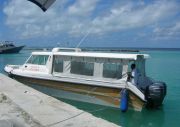 |
 |
 |
 |
 |
 |
The boat to Foammulah, departing from Gan, in Addu Atoll
 |
 |
Foammulah is also known by Fuvahmulah and by Fua Mulaku. It is a very pretty atoll with an exuberant nature. It is small (4.5 per 1.2 kilometres) and inhabited by about 11.000 souls in eight villages.
Great Moroccan traveller Ibn Battuta visited Foammulah in the XIV century and there he found two women that he added to his harem. In more recent times it has been explored by Norwegian Thor Heyerdahl.
There is no airport in Foammulah. In order to reach that small atoll you have first to get by plane to Gan, in Addu atoll, in the southernmost part of the Maldives, and then catch a boat to Foammulah (about 70 minutes journey). There is a single departure and they accept only 18 passengers (I bought the last ticket of the day).
People are very friendly, perhaps owing to the fact that this atoll is very rarely visited by tourists. In fact, the day that I visited Foammulah, I was the only foreigner, although the next day nine more tourists, friends of mine, would arrive from Gan in a private catamaran and would spend three hours. I could have joined them but I preferred to mix with the locals rather than chartering an expensive boat. Furthermore, I wanted to live there at least for a couple of days, what I did.
Upon arrival to the port of Foammulah I asked for the tourist attractions of the atoll and a local man helped me to visit the island on his motorcycle. During several hours he showed me the most interesting and beautiful places, such as the old Buddhist stupa, called Havitta (today covered by sand), since the times of King Asoka, the white sand beaches, the two fresh water lakes, the oldest mosque, the boatyards and some other lovely places. When we returned to the pier I wanted to thank him but he refused. Then I proposed to pay him, at least, for the petrol of his motorcycle and again he refused.
I only know that his name was Ibrahim.
Ibrahim would be the first of a large chain of local people who made my two days stay in Foammulah unforgettable.
|
|
| Favourite spots: |
 |
 |
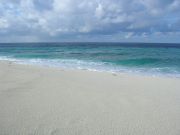 |
 |
 |
 |
 |
 |
The white beach, for my eyes only
 |
 |
Thoondu is a white beach in the north east of the island. Its sands are formed by white small round pebbles, which are unusually smooth and shiny.
You will not be the unique person in that beach; there are always local people there, especially children.
The first day in Foammulah I just visited that beach for about ten minutes, with my friend Ibrahim and his motorbike, but the next day, before the sailing of my catamaran back to Gan, I would walk there to enjoy it for over one hour.
The first time there were a few young boys having lunch in the beach, and the next day I saw complete schools with dozens of students playing football by the beach.
I heard bad news about the beach that second day. According to a teacher resting with his students in the beach of Thoondu, the islanders plan to construct an airport and hotels in that area, with the idea to convert Foammulah into a tourist resort.
|
|
| What's really great: |
 |
 |
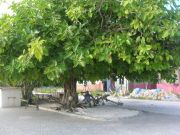 |
 |
 |
 |
 |
 |
While walking around the island, take a rest in a tree swing
 |
 |
Going around Foamullah on foot will take you between two and three hours and is the best way to get to know such an unexpected island. Wherever you will stop for a rest in a swing tree, or for drinking a tea or coffee, you will notice how people react by looking at you as an apparition. They are shy at the beginning but when you make the first step to communicate they will join you and will explain you about their island and the interesting places that you should not miss.
In one of these stops during my second day stay I learnt by the locals that Foammulah joined Addu Atoll in their independence from Maldives as the United Suvadive Republic, based on the geographical distance with Male and their own traditions and language, the “Mulaku Bas”, which is different from the Dhivehi.
The United Suvadive republic lasted four and a half years (from 1959 to 1963) owing to the Brithish betrayal. Finally the Suvadives had to capitulate to Male and form part of the Maldives against their will.
|
|
| Sights: |
 |
 |
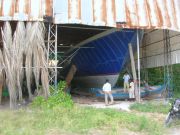 |
 |
 |
 |
 |
 |
Building boats in Foammulah. The workers are very friendly
 |
 |
One of the most curious activities of the locals, apart from fishing, is the boat construction. You can enter any of the many boatyards in Foammulah. The artisans will welcome you and will explain you their techniques to build boats.
You will be amazed by the great height of those boats. They sell them to Male and other places in the Maldives.
I asked them if they were fishing boats and was told that they are mainly used for transport of passengers and goods. Some of them even export cargo to nearby countries, such as India or Sri Lanka.
Long time ago the locals discovered in Foammulah a kind of tree durable in water, which wood is resistant to termites and they use it for the boat industry. The tree is called Jambul (Syzygium Cumini), can reach 10 metres height and its origin is from the south of Asia (Maldives, India, Indonesia, etc.), although presently you can find it in many other countries, for instance Venezuela and Brazil, in South America.
|
|
| Accommodations: |
 |
 |
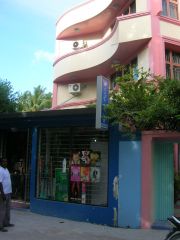 |
 |
 |
 |
 |
 |
Waadhee Mart hotel. I lived in the second floor
 |
 |
There are no hotels in Foammulah but a guest house called Waadhee Mart, where they charge in Maldivian rufiyaa an equivalent of about 10 euro per a single room with air condition plus TV and a bath room.
The owner has a supermarket on the ground floor, so it is very convenient if you want to buy mineral water plus fruits in case that you get thirsty or hungry during the night.
You can walk to Waadhee Mart form the port; it is at about one kilometre distance. First you take the road up the north of the island, walk about ten minutes, then you ask somebody and turn right.
In case that you do not want to spend money, the shipping office in the port has wooden benches where you can sleep, or you can use the swings under the trees for the same purpose. Those swings are a common place to sleep siesta by the locals in the afternoons, when it gets very hot in the island.
I could afford 10 euro, so I chose Waadhee Mart and I do not regret it.
|
|
| Nightlife: |
 |
 |
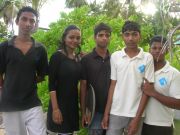 |
 |
 |
 |
 |
 |
The waiters in Royal restaurant. I understand why Ibn Battuta married two local girls in Foammulah
 |
 |
There are no night clubs or casinos in Foammulah. Furthermore, being Maldives a muslim country since the XII century, alcoholic drinks are prohibited (except for the foreigners in tourist resorts).
So the best thing to do in Foammulah is going to bed early in order to wake up when the sun rises and observe the fishing activities in the port.
But if, anyway, you want to experience some light night life, then you should go to the Royal Restaurant, in the port, a very romantic place with wonderful waiters and a waitress. I ordered a papaya juice and all the waiters and the only waitress were so curious about my presence that they came to talk to me, being so unusual seeing a foreigner.
I rarely give tips in restaurants (I do not remember even when I tipped the waiters for the last time, perhaps ten years ago, maybe twenty years ago…), but this time in Royal restaurant I made an exception and tipped generously because I loved the purity, graciousness and innocence of those boys and girl.
|
|
| Hangouts: |
 |
 |
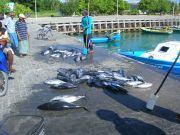 |
 |
 |
 |
 |
 |
Selling fish on the ground. One kilo tuna per 10 rufiyaa
 |
 |
My second day in Foammulah I woke up at 5.30 AM and run to the port in order to observe the fishermen arriving in their boats.
People in that island wake up very early; there was a lot of activity at that time in the port, and even an open cafeteria, very modest, called Bandari Garden (very appropriate name, Bandar meaning port in Persian language), offering tea and basic dishes and where I had breakfast.
During three hours I watched the open air fish market activities. Little by little the fishermen distributed on the floor the catch of the day, dividing the fishes by weight. I asked for the prices and was informed that 1 kilo tuna fish is sold by 10 rufiyaa.
Some men bought one fish, some others bought three, and there were who bought five or six.
Some married ladies completely covered with their chador, came with their motorcycles to the port to buy several fishes, and carried them home in the basket of the motorcycle.
|
|
| Restaurants: |
 |
 |
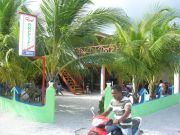 |
 |
 |
 |
 |
 |
Real Breeze restaurant. The man on the motorcycle is my friend Ibrahim
 |
 |
I had lunch in the restaurant Real Breeze thanks to my friend Ibrahim. It happened to be the best in the whole atoll. Apart from the typical fish dishes they also offered rice with curry, thali, samosas and other traditional Indian dishes, because Maldives is very close related to the cultures of south India and Sri Lanka.
I ordered tuna fish with vegetables.
The desserts were home made and delicious. I tried coconut cake with hot chocolate on the top.
Real Breeze is located not far from the port, at about ten minutes walking.
Maldives, in general, is a cheap country but Foammulah is still cheaper owing to the fact that has not been spoilt by the massive tourism, so you can order whatever you like and will pay a few rufiyaa for your meal.
If you are lucky enough you can join a regular night dinner with the locals in one of the eight Foammulah villages, where around a bonfire a whole community prepare tuna fish and talk about their islands.
|
|
| Other recommendations: |
Since, in order to get to Foammulah you have to call in the airport of Gan, the main village and island of Addu Atoll, it is worth to spend at least a couple of days there.
Gan is united to some of the islands forming Addu Atoll by causeways. You can rent a bicycle and visit several islands during a few hours.
Gan is very quiet, like, in general is the whole Addu Atoll. The local population ascends to about 30.000 people who like to play chess in the street and eat ice-creams in the many terraces of their cafeterias.
During the Second World War the Royal Marine made of Gan a base of operations. Some years later the base was transferred to the Royal Air Forces (RAF). In order to build an airport, the British destroyed forever a unique Hindu temple and a Buddhist stupa in the area.
Today, in the old British Head Quarters premises you will find a hotel called Equator Village.
|
|
Published on Saturday December 25th, 2010
|
|
 Publish on Facebook
Publish on Facebook
|
Tue, Feb 01 2011 - 12:44 PM
 by bootlegga
| Another great report on an out-of-the-awy place! |
Tue, Dec 28 2010 - 02:09 PM
 by mistybleu by mistybleu
| I love that you go to the unusual places, great report. |
Tue, Dec 28 2010 - 01:08 PM
 by antonioagui by antonioagui
Another pretty well explained report on a rarely reached place, full of humanity and proving once again that close to well-known touristical resorts there are still places for travellers.
Muchas gracias! |
Sun, Dec 26 2010 - 10:35 AM
 by krisek by krisek
| Grand report, Jorge. The Maldives have never been on my list of places to see, given the hype of exaggerated tourism industry. Yet, your story might have just changed my view. Many thanks, indeed. Plenty of practical information and tips here! |
Sun, Dec 26 2010 - 09:18 AM
 by szidonia by szidonia
| Jorge, I love this report of yours, the feeling of reading about Ibrahim, Ibn Battuta, the waiters and waitress, your constant stretched out awareness towards God throuhg the Self, reaching in places, people and even past travellers its never ending arrivals and destination. |
| Information: |
| Login if you are a member, or sign up for a free membership to rate this report and to earn globo points! |
|
| Afghanistan |
|
|
 |
| Argentina |
|
|
 |
| Bosnia - Herzegovina |
|
|
 |
| Brazil |
|
|
 |
| Canada |
|
|
|
|
|
|
 |
| Chad |
|
|
 |
| Chile |
|
|
 |
| China |
|
|
 |
| Christmas Island |
|
|
 |
| Colombia |
|
|
 |
| Dominica |
|
|
 |
| Falkland Islands |
|
|
 |
| Germany |
|
|
|

|
